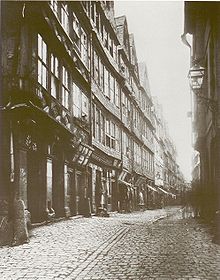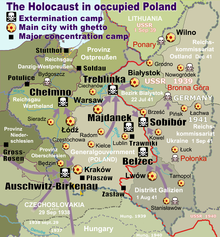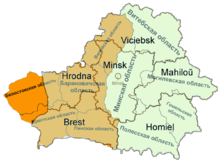Jewish ghettos in Europe
| Part of a series on |
| Antisemitism |
|---|
 |
|
|
| Part of a series of articles on |
| Racial and ethnic segregation |
|---|
 |
In the

In the 19th century, with the coming of
Origin
The ghetto system began in Renaissance Italy in July 1555 with Pope Paul IV's issuing of the Cum nimis absurdum. This change in papal policy implemented a series of restrictions on Jewish life that dramatically reshaped their place in society. Among these restrictions were the requirement of Jews to identify themselves by wearing a yellow badge, restrictions on the ownership of property, restrictions in commerce, and tighter regulations on banking. However, the most visible of these restrictions was the requirement of Jewish communities to reside in sectioned off, sanctioned neighborhoods known as ghettos.[3] The formation of the ghetto system also brought changes to Jewish economic activity. As a result of the Cum nimis absurdum regulations and the increasing complexity of the early modern economy, the role of Jews as money lenders became more difficult and less profitable. This as well as the fact that ghettos were often located at the town commercial centers drove Jews away from money lending and towards the role of second-hand merchants. In this role, Jews were forbidden from selling anything considered vital to life such as food or other high value commodities, so they gravitated towards reselling secondhand goods in the form of pawn shops.[4] Some scholars, however, have argued that this shift in papal policy inadvertently ended up improving some aspects of the Jewish experience relative to the medieval period. Jewish historian Robert Bonfil has argued that the formation of ghettos acted as a sort of middle ground between acceptance and expulsion by the Christian authorities. Following the formation of the ghetto system, there was a sharp decline in incidents such as pogroms, forced expulsion, and accusation of ritual murder that were common during the medieval period.[5]
World War II and the Holocaust

During
In 1942, the Nazis began
By country
Austria
- During World War II, an open type ghetto holding over 65,000 Jews was set up in the district of death factories, only 2,000 survived.[12]
Soviet Belarus
Following the Nazi German
- occupied Poland, holding 18,000 Jews, modern Brest, Belarus
- Łachwa Ghetto, occupied Poland, holding 2,350 Jews, modern Lakhva, Belarus
- Pińsk Ghetto, occupied Poland, holding 26,000 Jews, modern Pinsk, Belarus
- Słonim Ghetto, occupied Poland, holding 22,000–25,000 Jews, modern Slonim, Belarus
- Zdzięcioł Ghetto, occupied Poland, holding over 4,500 Jews, the site of the Dzyatlava massacre, modern Dzyatlava, Belarus
The Nazi ghettos set up in
- Minsk Ghetto in Minsk, today's capital of the Republic of Belarus, holding 100,000 Jews
- Bobruisk Ghetto Babruysk holding 25,000 Jews
- Vitebsk Ghetto Vitebsk holding 20,000 Jews
- Mogilev Ghetto Mogilev holding 12,000 Jews
- Gomel Ghetto in Gomel holding over 10,000 Jews; in Gomel Region alone, twenty ghettos were established in which no less than 21,000 people were imprisoned.[13]
- Slutsk Ghetto Slutsk holding 10,000 Jews
- Borisov Ghetto Barysaw holding 8,000 Jews
- Polotsk Ghetto Polotsk holding 8,000 Jews.[14]
Croatia
Dubrovnik
Established in 1546 by the former Republic of Ragusa.
Split
Established in 1738 by the former Republic of Venice.
Czech Republic
- Josefov, Prague; formerly the Jewish ghetto
- Jewish Quarter of Trebic
The Holocaust
France
Germany

Frankfurt
From its creation to its dissolution at the end of the 18th century, the city councils limited expansion in the Judengasse, resulting in a steady increase in population to the point of overcrowding. The original area of about a dozen houses with around 100 inhabitants, grew to almost 200 houses and some 3,000 inhabitants. The plots, originally quite generous, were successively divided while the total size of the ghetto remained the same. This increased the number of plots but subsequently reduced the size of each plot. In the process, many houses were replaced by two or more houses which were often divided in turn. Many of the houses were designed to be narrow and long, in order to maximize the limited space – the smallest house, the Rote Hase, was only about one and a half meters wide.
Friedberg
Jewish settlement during the Middle Ages all across the town, but since 1360 following a number of pogroms concentrating on the Judengasse (Jew's Row), running parallel to the main street.[15]
The Third Reich and World War II
At the
Hungary
- Ghetto Erzsébetváros, Budapest
At the turn of the 18th and 19th century the Jewish community gathered in the 7th district along the road leading to the bridge, with Király Street as its center. The city had not tolerated Jewish people for a long time. Joseph II’s regulation put an end to the prohibition in 1783. At that time there lived fourteen Jewish families in the immediate vicinity of Budapest, in the great mansion of Barons Orczy. Their numbers increased rapidly. Most of the largest Jewish community of the era moved from Óbuda, but many of them came from other areas of the Habsburg empire.
In 1944 the Pest Ghetto was built here in the neighborhood bordered by Király Street, Csányi Street, Klauzál Square, Kisdiófa Street, Dohány Street and Károly Boulevard, crowding 70,000 people together. One of the borders of the ghetto was the Row of Archways on the Wesselényi Street side. In 2002 this area was named the old Jewish neighborhood of Pest and was entered into the Budapest world heritage conservation zone. This area features most of the Jewish heritage sites of the Pest side, including the famous "Synagogue Triangle."
Italy

Mantua
In 1590, Vincenzo Gonzaga expelled all foreign-born Jews from Mantua; in 1602, he forbade Jewish physicians from treating Christian patients without special permission; in 1610 he established a ghetto, and in 1612 compelled all Jews to live in it.[20] In 1610 Jews constituted about 7.5 percent of the population of Mantua.[21] In 1630 the Mantua ghetto was sacked by imperial troops and destroyed.[22] Among the Jewish dead or missing were the composer Salamone Rossi and his sister the opera singer Madama Europa.[23]
Piedmont
- Some ancient ghettos in Bra, Nicastro
Papal States

- Ghetto of Ancona, established in 1555 by the Cum nimis absurdum of Pope Paul IV. The inhabitants of the ghetto were the richest Jewish merchants of the Papal States.
- Ghetto of Ferrara, established in 1627.
- Kingdom of Italy took Rome from the Popeand the ghetto was finally opened, with the walls themselves being torn down in 1888.
- Ghetto of Urbino, established in 1631.
Venice
Although there is evidence indicating the presence of Jews in the Venetian area dating back to the first few centuries AD, during the 15th and early 16th centuries (until 1516), no Jew was allowed to live anywhere in the city of Venice for more than 15 days per year; so most of them lived in Venice's possessions on the terrafirma. At its maximum, the population of the ghetto reached 3,000. In exchange for their loss of freedom, the Jews were granted the right to a Jew's coat (the colour yellow was considered humiliating, as it was associated with prostitutes). The gates were locked at night, and the Jewish community was forced to pay the salaries of the patrolmen who guarded the gates and patrolled the canals that surrounded the ghetto. The ghetto was abolished after the fall of the Republic of Venice to Napoleon.
Sicily

The Sicilian Jews lived in medieval neighborhoods. The Sicilian Jewish quarter giudecche were abandoned by their inhabitants at the end of the Medieval Era because the expulsion of the Jews from Sicily in 1493.
Southern Italy


While not exactly ghettos, the giudecche of southern Italy were medieval and Early Modern Jewish quarters. The Jews of the region often lived in these neighborhoods either for safety reasons or by the compulsion of Christian authorities. After the expulsion of the Jews from the Kingdom of Naples in 1541, these neighborhoods lost their distinctive Jewish character, and now only traces of evidence remain of the original inhabitants. There were Jewish quarters known as giudecche in Abruzzo, Basilicata, Campania, Calabria, Molise and Apulia.
Lithuania
Poland
For centuries, Poland was home to one of the largest and most significant Jewish communities in the world. Polish monarchs of the
The Holocaust
Nearly complete
The Warsaw ghetto contained more Jews than all of France; the Lodz ghetto more Jews than all of the Netherlands. More Jews lived in the city of Cracow than in all of Italy, and virtually any medium-sized town in Poland had a larger Jewish population than all of Scandinavia. All of southeast Europe – Hungary, Romania, Bulgaria, Yugoslavia, and Greece – had fewer Jews than the original four districts of the General Government. —
Christopher Browning[36]
A more complete list of over 260 ghettos with approximate number of prisoners, date of creation and liquidation, as well as known deportation route to

Starting in 1939,
The situation in the ghettos was usually brutal. In Warsaw, 30% of the population were forced to live in 2.4% of the city's area. In the ghetto of Odrzywol, 700 people lived in an area previously occupied by 5 families, between 12 and 30 to each small room. The Jews were not allowed out of the ghetto, so they had to rely on replenishments supplied by the Nazis: in Warsaw this was 181 calories per Jew, compared to 669 calories per non-Jewish Pole and 2,613 calories per German. With crowded living conditions, starvation diets, and little sanitation (in the Łódź Ghetto 95% of apartments had no sanitation, piped water or sewers) hundreds of thousands of Jews died of disease and starvation.
The
Spain
Phase-wise segregation of the Jewish population from an intermixed settling throughout the Middle Ages until the Expulsion of the Jews from Spain in 1492.[43]
The Netherlands
- Jodenbreestraat ("Jewish Broad Street"), Amsterdam
Jodebreestraat was a street "in the very heart of the Jewish quarter."
Following the
Turkey
- Balat, European Istanbul
References
- ^ GHETTO Archived 2008-05-11 at the Wayback Machine Kim Pearson
- ^ Types of Ghettos. United States Holocaust Memorial Museum, Washington, D.C.
- ISBN 978-0-520-07350-0.
- ISBN 978-0-520-07350-0.
- ISBN 978-0-520-07350-0.
- ^ An article about the Kraków Ghetto in English with photos
- ^ About Kraków Ghetto in Polish with valuable historical photos
- ^ Schindler's Krakow Archived August 15, 2004, at the Wayback Machine - modern-day photographs
- ^ JewishKrakow.net Archived September 30, 2011, at the Wayback Machine - A page on the Krakow Ghetto complete with contemporary picture gallery
- ISBN 0-7425-4666-7. Accessed April 3, 2012.
- ^ Richard C. Lukas, Out of the Inferno: Poles Remember the Holocaust University Press of Kentucky 1989 - 201 pages. Page 13; also in Richard C. Lukas, The Forgotten Holocaust: The Poles Under German Occupation, 1939-1944, University Press of Kentucky 1986 - 300 pages.
- ^ Encyclopedia of Jewish and Israeli history (2016). "Vienna, Austria Jewish History Tour". Jewish Virtual Library.
- ^ Dr. Leonid Smilovitsky (September 2005). Fran Bock (ed.). "Ghettos in the Gomel Region: Commonalities and Unique Features, 1941-42". Letter from Ilya Goberman in Kiriat Yam (Israel), September 17, 2000. Belarus SIG, Online Newsletter No. 11/2005.
Note 16: Archive of the author; Note 17: M. Dean, Collaboration in the Holocaust.
- ^ "Gosudarstvenny arkhiv Rossiiskoy Federatsii (GARF): F. 8114, Op. 1, D. 965, L. 99" Государственный архив Российской Федерации (ГАРФ): Ф. 8114. Оп. 1. Д. 965. Л. 99 [State Archive of the Russian Federation] (PDF). 110, 119 / 448 in PDF – via direct download, 3.55 MB from Iz istorii evreiskoi kultury.
Геннадий Винница (Нагария), »Нацистская политика изоляции евреев и создание системы гетто на территории Восточной Белоруссии«
{{cite journal}}: Cite journal requires|journal=(help) - ^ "Die Synagoge in Friedberg". Allemania-judaica.de (in German). Allemania Judaica - Arbeitsgemeinschaft für die Erforschung der Geschichte der Juden im süddeutschen und angrenzenden Raum. 18 July 2014. Retrieved 5 August 2014.
- ^ Polish Ministry of Foreign Affairs, German Occupation of Poland. (Washington, D.C.: Dale Street Books, 2014), pp. 12-16. See also: Mass Extermination of Jews in German Occupied Poland from the same source in public domain.
- ^ Hague IV Archived 2015-05-25 at the Wayback Machine SECTION III MILITARY AUTHORITY OVER THE TERRITORY OF THE HOSTILE STATE (Art. 42. and later)
- ISBN 978-3-486-58206-2
- ^ Czesław Łuczak, "Położenie ludności polskiej w Kraju Warty 1939–1945. Dokumenty niemieckie", Poznań 1987, pages V-XIII
- ^ Gotthard Deutsch, Ismar Elbogen, and Joseph Jacobs, "Mantua," from The Jewish Encyclopedia, 1906, URL=http://www.jewishencyclopedia.com/articles/10381-mantua
- ^ Paul F. Grendler The University of Mantua, the Gonzaga & the Jesuits, 1584-1630 2009 "The ghetto was adjacent to the Jesuit island, the block of buildings that included the Jesuit church, residence, and school (see chapter 2 and map 3). In 1610 Jews constituted about 7.5 percent of the population of Mantua:
- ^ Shlomo Simonsohn History of the Jews in the Duchy of Mantua Kiryath Sepher, 1977 "The order was published in the ghetto late that night. On Tuesday, 21st of Ab (30.7.1630), a German officer robbed Monte di Pieta, with the aid of one of the clerks of the institution and a twenty-two-year-old Jew named Aaron Cohen. Massarano attempts to justify the Jew's act by saying that the others forced him to take part in the robbery. The Germans arrested the Jew and he was hanged. Prior to the departure of the Jews from Mantua, the Germans seized hostages from among the leaders of the community ... On Wednesday, the 22nd of Ab, the Jews gathered for a final prayer in the nine synagogues of the ghetto, after which they left Mantua.... ."
- ^ Don Harrán Salamone Rossi, Jewish musician in late Renaissance Mantua
- ISBN 9789027932396.
Polish rulers of the Piast dynasty invited the Jews to the country to create commerce and industry, granting them privileges of status....They were to enjoy complete religious tolerance.
- ^ "Poland – Virtual Jewish History Tour" at Jewish Virtual Library.
- ^ "Polish Jews History", at PolishJews.org
- ^ Reconstructing Languages and Cultures, Robert D. King, page 422
- ^ Europe and the Jews: The Pressure of Christendom on the People of Israel for over 1900 years
- ^ a b c d "Synagogues of the Kazimierz historic district in Krakow" at Krakow Info.com
- ^ Jewish Krakow, A Visual and Virtual Tour,"Jewish Krakow - Kupa Synagogue". Archived from the original on February 14, 2008. Retrieved February 14, 2008.
{{cite web}}: CS1 maint: unfit URL (link) of Kazimierz district of Kraków - Museum of the History of the Polish Jews (in English), as well as "Getta Żydowskie," by Gedeon, Archived November 22, 2012, at the Wayback Machine(in Polish) and "Ghetto List" by Michael Peters at www.deathcamps.org/occupation/ghettolist.htm (in English). Accessed June 21, 2011.
- ^ Warsaw Ghetto, United States Holocaust Memorial Museum (USHMM), Washington, D.C.
- ^ Ghettos, United States Holocaust Memorial Museum
- ^ Berenbaum, Michael. The World Must Know," United States Holocaust Museum, 2006, p. 104.
- ^ Poland's Holocaust by Tadeusz Piotrowski. Published by McFarland.
- ISBN 978-0-521-55878-5– via Google Books.
- ^ October 8: First Jewish ghetto established in Piotrkow Trybunalski, Archived 2009-01-06 at the Wayback Machine Yad Vashem The Holocaust Martyrs' and Heroes' Remembrance Authority
- ^ Holocaust Encyclopedia: Types of Ghettos. United States Holocaust Memorial Museum, Washington, D.C.
- ^ Dwork, Deborah and Robert Jan Van Pelt,The Construction of Crematoria at Auschwitz W.W. Norton & Co., 1996.
- ^ University of Minnesota, Majdanek Death Camp
- ^ Cecil Adams, Did Krups, Braun, and Mercedes-Benz make Nazi concentration camp ovens?
- ISBN 0-88125-630-7, 302 pages. Quote: ... the so-called Gross Aktion of July to September 1942... 300,000 Jews murdered by bullet of gas (page 35).
- ^ "Plasencia". Redjuderias.org. 2012. Retrieved 5 August 2014.
- ^ a b Reuben ben Gershom-Goossens D.Litt., "Dutch Tzedakah. Stories of “Righteous Ones” in the Netherlands", 1998 - 2008
- ^ Reuven Goossens, "Dutch Tzedakah. Stories of “Righteous Ones” in the Netherlands. Part Two: The Dockworker", 1998 - 2008

